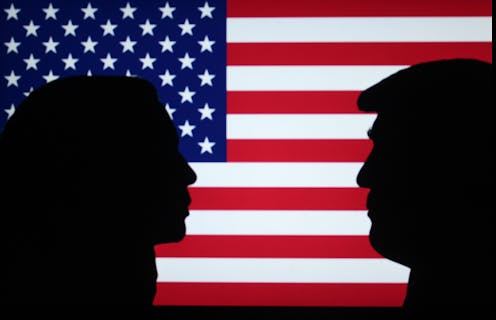Harris nudges ahead of Trump in the polls – but could the economy prove her downfall?
- Written by Paul Whiteley, Professor, Department of Government, University of Essex

The current US vice-president and Democratic presidential candidate, Kamala Harris, appears to have nudged ahead of her Republican rival, Donald Trump, in the race to the White House.
A poll of polls, which combines polls from different agencies, published on the website FiveThirtyEight on October 22 shows that Harris leads Trump[1] by 48.1% to 46.3% in national voting intentions. So the race remains very tight.
There is naturally a lot of attention being paid to what is happening in swing states[2] such as Pennsylvania, Michigan, Georgia and North Carolina. However, the polling in these states is not very helpful since it currently predicts a dead heat in practically all of them.
In the key swing state of Pennsylvania, for example, 47.8% of people intend to vote[3] for Trump compared to 47.6% for Harris. This gap is well within the margin of error, so FiveThirtyEight[4] calls it an even contest.
One of the surveys[5] in the poll of polls was conducted by YouGov for the Economist newspaper. It shows that 19% of respondents have already voted in the election and a further 72% say they will definitely vote. When registered voters were asked which candidate they think is likely to win, the replies were a dead heat – 38% of them chose Harris and 38% Trump (24% are not sure).
Another way of judging the contest is to look at who has the advantage in the key drivers of the vote in the election. In an earlier article[7], I argued that Harris leads Trump in the presidential race in three of the four key measures that explain voting behaviour.
She is ahead in likeability, and is favoured by more moderates than Trump. Harris also has more support from Republican identifiers than Trump has among voters who identify as Democrats. However, in relation to the fourth driver, which is the issues voters care about, she is at a clear disadvantage.
Read more: Harris leads Trump in the polls – here's what they really tell us about her chances[8]
The Economist/YouGov poll shows that 96% of respondents think that jobs, inflation and the economy are important issues in the election. In the same poll 84% think immigration is important and 75% think this about abortion.
Harris’s problem is that polling indicates she is well behind Trump on the issue of the economy. When asked if Harris or Trump would do the best job dealing with inflation, for example, 39% preferred Harris and 46% Trump. This is despite the fact that the most recent inflation rate is relatively low[9] at 2.4%, and has been falling for some time.
On the issue of abortion she does much better. Some 50% of Americans approve her pledge to restore the right to abortion enshrined in the Roe v Wade case from 1973, which was reversed by a Supreme Court ruling[10] in 2022. In comparison, only 33% of Americans approve of Trump’s position to uphold the court ruling.
Does it really matter if Harris is behind on the economy? There is historical evidence to suggest that, if we look at the actual performance of the economy as opposed to polls, Harris may have an advantage.
The graph below shows the relationship between voting for an incumbent Democratic or Republican president (or his party’s nominee) and the state of the economy over a century of presidential elections from 1920 to 2020.
In the chart, the performance of the economy is captured by two measures. The first is economic growth in real terms and the second is the misery index (the sum of inflation and unemployment). Both are measured in the year of the elections.
There is a strong positive correlation between growth and voting for the incumbent president or his party’s nominee (+0.55). When growth is buoyant, the incumbent or his successor does well. And when it is weak, they do badly.
There is also a negative relationship between the misery index and presidential voting. But, in this case, the correlation is very weak (-0.05). This means that, while voters may complain about inflation and unemployment and blame the incumbent president’s administration, economic growth is the real driver of voting in these elections.
Economic growth is the real driver of voting in US elections







